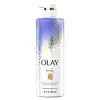Naturium The Smoother Glycolic Acid Exfoliating Body Wash Versus Olay Cleansing & Renewing Nighttime Body Wash with Retinol and Vitamin B3 Complex
What's inside
What's inside
 Key Ingredients
Key Ingredients

 Benefits
Benefits

 Concerns
Concerns

 Ingredients Side-by-side
Ingredients Side-by-side

Water
Skin ConditioningSodium Cocoyl Isethionate
CleansingGlycolic Acid
BufferingSodium Hydroxide
BufferingSodium Methyl Cocoyl Taurate
CleansingGlycol Distearate
EmollientLactic Acid
BufferingMalic Acid
BufferingPyruvic Acid
MaskingTartaric Acid
BufferingSodium PCA
HumectantPolyquaternium-73
Cocamide Mipa
EmulsifyingCocamidopropyl Hydroxysultaine
CleansingChondrus Crispus Extract
Skin ConditioningPolyquaternium-10
Glycerin
HumectantCaprylyl Glycol
EmollientDidecyldimonium Chloride
EmulsifyingMethylpropanediol
SolventPolyquaternium-80
CleansingCitric Acid
BufferingTetrasodium Glutamate Diacetate
Sodium Lactate
BufferingWater, Sodium Cocoyl Isethionate, Glycolic Acid, Sodium Hydroxide, Sodium Methyl Cocoyl Taurate, Glycol Distearate, Lactic Acid, Malic Acid, Pyruvic Acid, Tartaric Acid, Sodium PCA, Polyquaternium-73, Cocamide Mipa, Cocamidopropyl Hydroxysultaine, Chondrus Crispus Extract, Polyquaternium-10, Glycerin, Caprylyl Glycol, Didecyldimonium Chloride, Methylpropanediol, Polyquaternium-80, Citric Acid, Tetrasodium Glutamate Diacetate, Sodium Lactate
Water
Skin ConditioningPetrolatum
EmollientSodium Trideceth Sulfate
CleansingSodium Chloride
MaskingCocamidopropyl Betaine
CleansingTrideceth-3
EmulsifyingParfum
MaskingNiacinamide
SmoothingRetinol
Skin ConditioningRetinyl Propionate
Skin ConditioningSodium Citrate
BufferingGuar Hydroxypropyltrimonium Chloride
Skin ConditioningSodium Benzoate
MaskingXanthan Gum
EmulsifyingGlyceryl Oleate
EmollientCitric Acid
BufferingDisodium EDTA
Sodium Hydroxide
BufferingAcrylates/C10-30 Alkyl Acrylate Crosspolymer
Emulsion StabilisingMethylchloroisothiazolinone
PreservativeMethylisothiazolinone
PreservativeCI 19140
Cosmetic ColorantCI 17200
Cosmetic ColorantWater, Petrolatum, Sodium Trideceth Sulfate, Sodium Chloride, Cocamidopropyl Betaine, Trideceth-3, Parfum, Niacinamide, Retinol, Retinyl Propionate, Sodium Citrate, Guar Hydroxypropyltrimonium Chloride, Sodium Benzoate, Xanthan Gum, Glyceryl Oleate, Citric Acid, Disodium EDTA, Sodium Hydroxide, Acrylates/C10-30 Alkyl Acrylate Crosspolymer, Methylchloroisothiazolinone, Methylisothiazolinone, CI 19140, CI 17200
 Reviews
Reviews

Ingredients Explained
These ingredients are found in both products.
Ingredients higher up in an ingredient list are typically present in a larger amount.
Citric Acid is an alpha hydroxy acid (AHA) naturally found in citrus fruits like oranges, lemons, and limes.
Like other AHAs, citric acid can exfoliate skin by breaking down the bonds that hold dead skin cells together. This helps reveal smoother and brighter skin underneath.
However, this exfoliating effect only happens at high concentrations (20%) which can be hard to find in cosmetic products.
Due to this, citric acid is usually included in small amounts as a pH adjuster. This helps keep products slightly more acidic and compatible with skin's natural pH.
In skincare formulas, citric acid can:
While it can provide some skin benefits, research shows lactic acid and glycolic acid are generally more effective and less irritating exfoliants.
Most citric acid used in skincare today is made by fermenting sugars (usually from molasses). This synthetic version is identical to the natural citrus form but easier to stabilize and use in formulations.
Read more about some other popular AHA's here:
Learn more about Citric AcidSodium Hydroxide is also known as lye or caustic soda. It is used to adjust the pH of products; many ingredients require a specific pH to be effective.
In small amounts, sodium hydroxide is considered safe to use. However, large amounts may cause chemical burns due to its high alkaline.
Your skin has a natural pH and acid mantle. This acid mantle helps prevent harmful bacteria from breaking through. The acid mantle also helps keep your skin hydrated.
"Alkaline" refers to a high pH level. A low pH level would be considered acidic.
Learn more about Sodium HydroxideWater. It's the most common cosmetic ingredient of all. You'll usually see it at the top of ingredient lists, meaning that it makes up the largest part of the product.
So why is it so popular? Water most often acts as a solvent - this means that it helps dissolve other ingredients into the formulation.
You'll also recognize water as that liquid we all need to stay alive. If you see this, drink a glass of water. Stay hydrated!
Learn more about Water